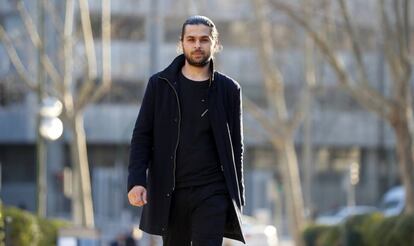Khaled’s two journeys to Spain
He was the first Syrian national to seek asylum at the Melilla border station. A bureaucratic glitch saw him flee the country to seek refuge elsewhere in Europe, but he was sent back to Spain. Now, Khaled is a happy Madrid resident who holds a job and dreams of opening his own restaurant one day

“Do you want to be a refugee here?" When he heard the question, Khaled al Dieri, 26, says he felt an inner peace that had been missing for a long time. “Yes,” he replied without hesitation.
That was September 21, 2014. Khaled had fled Syria three years earlier, after shrapnel got lodged into his foot at a street march in his hometown of Deraa, the birthplace of the protests that led to civil war.
At that point, Khaled could not even imagine he would eventually end up in Spain and become the first person to file for asylum at the Melilla border. Nor was he aware that there was another enemy waiting around the corner: the complicated rules that govern refugee applications in Spain, and that are highlighting Europe’s lack of solidarity towards the flood of people from around the world seeking protection.
“I always heard that Europe was the best place,” says Khaled, sitting on a bench inside a park in the north of Madrid, where he is now studying and working as a cook.
Last year, Spain received 15,570 asylum applications, of which nearly 3,000 were filed by Syrian nationals
But to test that claim, this Syrian, who is always smiling, had to cross many borders and experience first-hand the contradictions inherent in Europe’s immigration and asylum policies – from overcrowded shelters to deportations backed by the Dublin regulation, which says migrants must request asylum in the first European country they enter.
After traveling to Jordan in the hopes of receiving surgery for the wound in his foot, he moved on to Egypt, then Algeria, and finally to Morocco. There, he refused to pay the mafias that block the route to the Spanish border station of Beni Ensar, which provides access to the Spanish exclave of Melilla. It took him three attempts, but he made it through.
“They told me I was the first person to come through legally in who knows how long,” he recalls.
Beni Ensar has since become the Spanish entry point that receives the most applications, says María Jesús Vega, spokeswoman for the United Nations High Commissioner for Refugees (ACNUR) in Spain. After Khaled, around 10,000 more people managed to request international protection at this border outpost, although that figure has been dwindling because Algeria and Tunisia have begun asking Syrians for visas.
Last year, Spain received a record number of asylum applications: 15,570, of which nearly 3,000 were filed by Syrian nationals, according to the latest Eurostat figures. Of the 10,250 requests that were processed, nearly 7,000 received favorable answers.
On the other hand, a 2009 legal reform has practically eliminated the possibility of requesting asylum at Spanish embassies abroad, meaning that protection seekers are forced to risk their lives to apply in person at a Spanish border point.
I spent a month on the streets and then had to go back to Melilla Khaled
ACNUR established a permanent presence at the Beni Ensar border station in June 2014, when there was a spike in Syrian arrivals. In early 2015, the Interior Ministry set up an office to speed up processing. But these options are out of reach to citizens of specific countries, who have no choice but to try to jump the fence and gain illegal entry into Spain.
“Morocco’s role as a policeman has had consequences: Syrians and Moroccans have to pay the mafias, while sub-Saharan Africans have no way in,” says Antonio Zapata, a lawyer in Melilla.
All asylum seekers at the border have to wait inside a facility known as CETI (Temporary Immigrant Stay Center) until their application is either approved or rejected. The law says this should not take longer than four days, but this period is hardly ever observed. And the Melilla CETI “is overcrowded and lacks the conditions to be considered a place of shelter,” says Vega.
“The problem is that, due to Spain’s bad practices, they have become long-term centers where applicants’ rights are not respected,” says Paloma Favieres, who coordinates the legal services at the Spanish Refugee Aid Commission (CEAR).
Khaled spent three months at the Melilla CETI while his own application was being processed. He compares it to “an animal house.” He slept in bunk beds under the roof, and one day when it rained, the room flooded and the water reached up to his back – a back already hurting from the beatings he received in a Syrian prison, where he was held for over a year after telling a classmate at school that he disagreed with the policies of President Bashar al Assad.
Once he received his “red card,” a temporary document that does not allow recipients to leave the country, he was transferred to Malaga. But things did not improve. “I spent a month on the streets [until I was told] that there was a problem with my name and that I had to go back to Melilla,” he recalls.
Instead, he fled to France and Belgium. “From day one I had a place to sleep, eat and learn the language.” But the Dublin law was enforced, and he was sent back to Spain. “I felt awful, I didn’t want to be back here,” he confesses.
Khaled had fled Syria after shrapnel lodged into his foot at a protest march in his hometown of Deraa
After spending time at two different Madrid shelters, Khaled was finally granted refugee status – later than the legally established deadlines. Cristina Gortázar, a researcher on refugee issues at Pontificia Comillas University, notes that applications should be processed in six months. “But this does not happen: decisions take two years and more,” she says.
Now, Khaled wants to stay in Spain. He is renting out a room and found a job three months ago at a restaurant chain, where he works as a cook. He wants to pursue his childhood dream of opening his own restaurant one day, and is taking online courses thanks to help from a social worker.
Most of his family is still back in Syria, except for his father, who fled to Kuwait, and a sister, who made it to Turkey, a country that Khaled describes as “very dangerous.”
He is proud of himself because last month, for the first time, he was able to send money back to his family. The shrapnel is still stuck in his foot, though.
“You know what?” he says. “It hurts, but I don’t care anymore.”
This story is part of a project called The New Arrivals, funded by the European Journalism Centre with support from the Bill & Melinda Gates foundation, in which EL PAÍS is a participating member together with The Guardian, Der Spiegel and Le Monde.
English version by Susana Urra.


